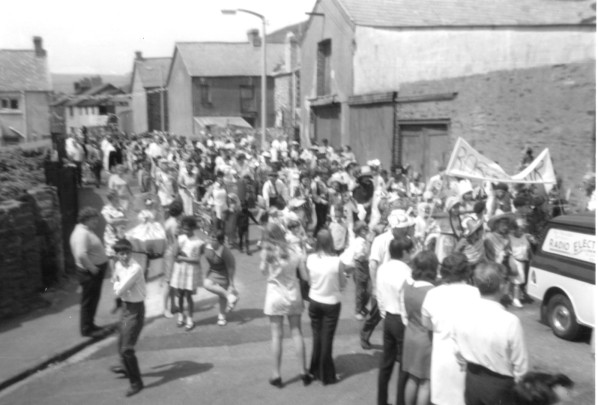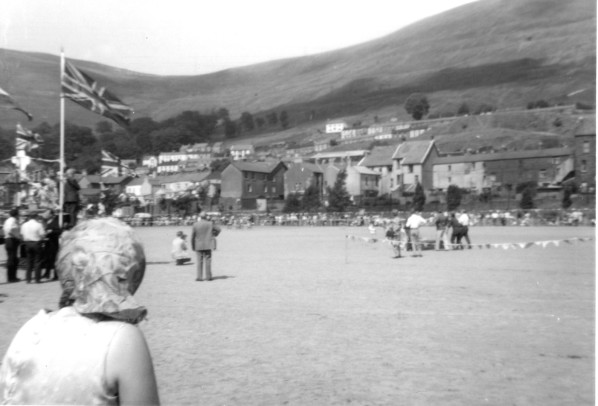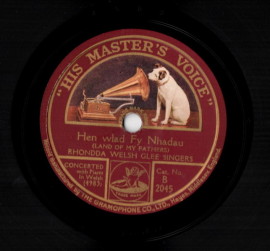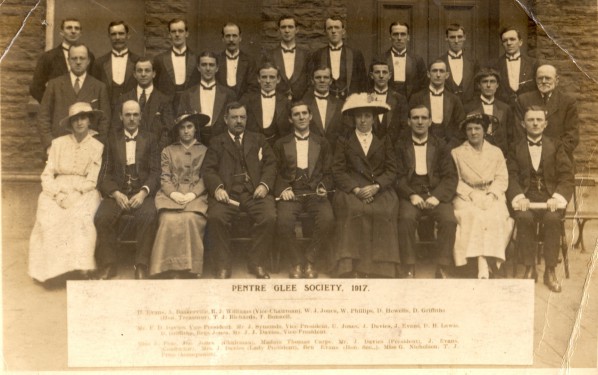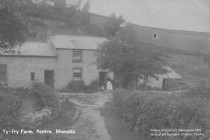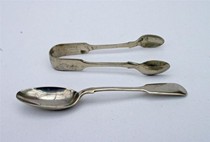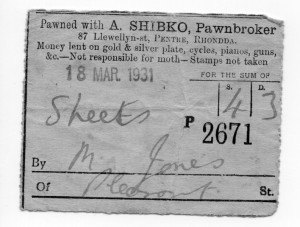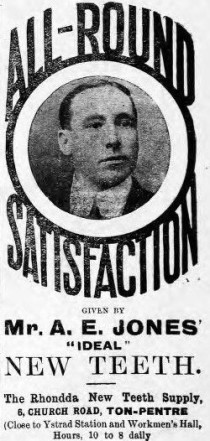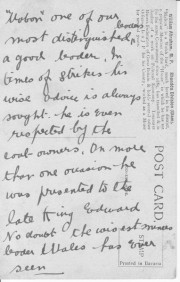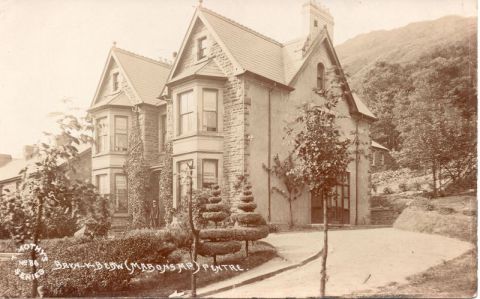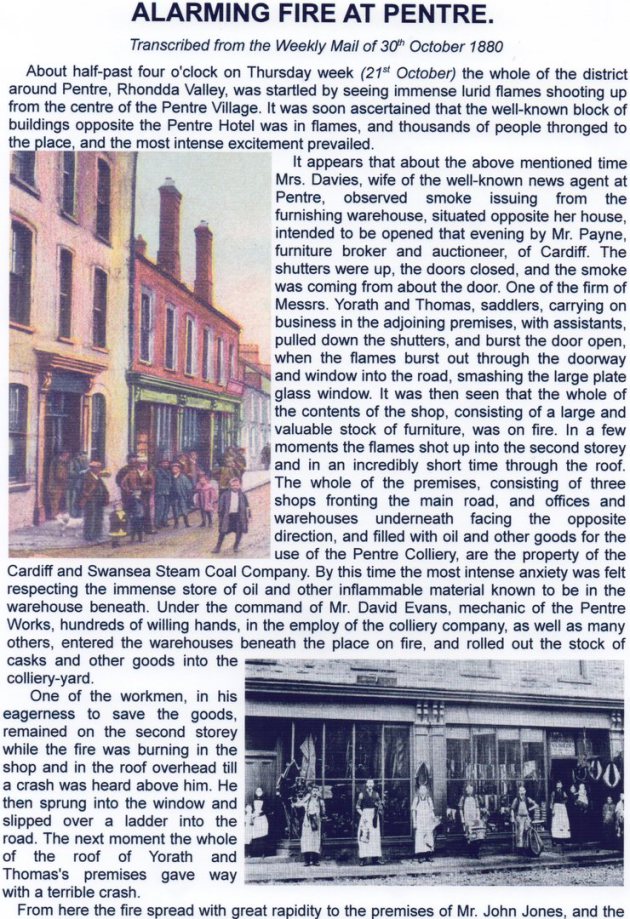
Pentre's Past
Once upon a time, as they say, the areas now known as Pentre, Ton and Maendy were just a collection of small subsistance farmsteads dotted around the sides of the extremely isolated Rhondda Fawr valley, part of the massive parish of Ystradyfodwg. There were no roads as we know them today, only a network of rough tracks, most of which were just passable on foot or horse-back. The "main" routes of the day were along the tops of the hills, to avoid the frequently flooded valley floor, which were reached by narrower, often very steep tracks climbing up from the various farmsteads. The river was much wider and shallower than it is now, and followed a much more meandering course. Old maps show many fords and these would been where the "local" tracks linking the farms crossed. Bridges were something of a novelty! As late as 1929 these tracks were the only way out of the top of valley and segments of them still survive as footpaths today - though argueably they should nearly all be bridleways.
The onset of the mining era saw a fairly rapid growth in the valley's population, with the influx of people seeking work in the mines, thus farmsteads became hamlets, then villages and small towns until eventually there was almost continuous housing from one one end of the valley to the other. The need to move coal out of the valleys led to the introduction and rapid expansion of the railway network, and the construction of the tunnel between Blaencwm and Blaengwynfi provided for the first time an alternative, feasible way in and out of the valley, without going through Porth. Eventually, a proper road network was established, and for a short time even trams ran in the valley.
Take the tram to Sandy Bank
to consult Professor VERO
This advert from the Rhondda Leader, just one of many which appeared between 1909 and 1912, is included not just because the "testimonial" was from a Ton Pentre resident, but because the "professor" actually lived in Pentre at 33 Llewellyn Street which is one of the properties which existed where the council staff car park now is. Effectively a stage name, the prof's real name was John Cornelious Oliver who was born in Poplar, London, a descendant of one of the many Oliver families that moved up from Cornwall in the mid-1800s.
An interesting chap to research as it seems he was officially declared dead in 1909. He was living with his first wife and three children in Bristol earning a living as a conjuror when in 1898 he left to take up a pantomime engagement in Worcester. After this his wife made numerous unsuccessful attempts to contact him. The probate court gave leave to presume him dead in June 1909.
Given that he married his second wife (Madame Vero in the advert) in 1899 and had fathered several children with her whilst she too was still married, this erstwhile conjuror had added bigamy to his bag of tricks. For his last trick he married again in 1936 whilst both his first and second wives were still alive. He died in 1943.
PENTRE PARK Carnival: Some snapshots from 196?
WHAT'S IN A NAME?
Family trees are a useful source of information, and can often provide clues as to the origins of local street names. The 1847 tithe maps show which "landed gentry" owned various areas of the Rhondda at the time.
For Example Griffith LLewellyn had the Pentre area, so Llewellyn Street runs from one side of his "patch" to the other, and you also find Catherine Street, Thomas Street and Elizabeth Street (brother and sisters) whilst Baglan Street reflects his home at Baglan Hall and Madeline Street his wife. David Treharne, Griffith Llewellyns Estate Agent, who later acquired much of Pentre Farm, might well account for Treharne Street.
In Ton, one of the estates of Crawshay Bailey II, you will find Llanfoist Street, the house near Abergavenny he inherited from his father. Of course Crawshay Street and Bailey Street are obvious. He married Elizabeth Selina Madeline Metaxa (Metaxa Street) and then you have his two daughters which give you Clara Street and Augusta Street. Clara married a William Gordon Canning, thus Gordon and Canning Streets.
RHONDDA
WELSH
GLEE
SINGERS
Formed in Pentre
in 1877, and, it
would seem, arch
rivals of the
Treorchy Male
Choir formed a
few years later.
Some of their interesting history is told on the Treochy Male Choir website. I particularly like the notion of the Glee Singers pulling up the tent pegs on the Treorchy Choir during one of their performances in a marquee.
see www.treorchymalechoir.com/history
Pentre Glee Society 1917
The Cory Workmens Silver Band
ONE MAN AND HIS DOG
Ton Pentre Sheep Dog Trials
The first annual Ton Pentre sheep dog trials were held on Ton Farm, Ton Pentre on Tuesday in rather unfavourable weather. the officials were:- President: Mr G.H.Smith agent Bailey Estate. Vice-president: Mr W.D.Wright, M.E. Rhondda Rise. Judges: Messrs Frank Thomas, Wellfield, Builth: J.D.Williams. J.P., M.F.H., Clydach Court: D.Ll.Treharne, Pentre House: T.Williams, Tonypandy, and J. Morgan, Tynewydd. Timekeepers: Mr. Piesold, Pentre, and Mr. M. Williams, veterinary surgeon.There were 29 entries in the open class and 21 in the novice. The results were as follows:- 1st, "Lass" owned by Mr.John Jones, Pantyilgwyn, Llanwrtyd (time 9 mins 40secs): 2nd:- "Juno" owned by Mr. David Harry, Velindre, Morriston (9 mins 20secs); 3rd, "Ross" owned by Mr. J.Jones, Ffynnondwyn Farm, Clydach Vale. This dog did not succeed in penning any of the sheep. Novice Class: 1st, "Moss" owned by Mr. David Walters, Penrheol Farm, Tylorstown. 2nd, "Fly" owned by Mr. D.W.Evans, Glynfach Farm, Porth: 3rd, "Rover" owned by Mr J. Jones, Ffynnondwyn Farm, Clydach: special 4th, "Wag" owned by Mr. David Bevan Jnr, Bolgoed bFarm, Pontardulais. The contests were very severe, owing to the ground being quite open and the sheep of the wildest character.
A report in the "Western Mail" of 28th September 1898.
A PENTRE TRADER LONG GONE
ADOLPH FUHRER - Jeweller
Llewellyn Street, Pentre
At the height of the mining era, most of the premises in Llewellyn Street and Ystrad Road were shops. Most have now been converted to private houses.
In the early 1900s Adolph Fuhrer lived in Treorchy where he had premises next to what is now the Spar Shop, He maintained a "branch" shop run by a manager in Llewellyn Street. The spoon and sugar nips are an example of items which could be purchased.
THE CORONATION OF
KING GEORGE V
22nd June 1911
Pentre Celebrates
The then Rhondda Urban District Coucil provided no less than 34,000 children at the schools with tea, a medal and a new penny (1d) each. The whole of the district was prettily decorated, whilst illuminations in the evening were on a lavish scale. A firework display took place in the evening in the grounds of the Higher Grade School.
RIVERSIDE SOCIAL CENTRE
1937 Documentary film:
"Today We Live"
A short film produced by The Strand Film Company for the then National Council of Social service followed two stories, told in parallel, about self-help schemes available at the time in deprived areas. The people seen in the film actually lived in the communities, and the film shows their attempts to improve their environment and living conditions. The story about Pentre follows the building, by unemployed coal miners of an occupational centre for learning new skills such as carpentry and shoe repairing. There are a few brief glimpses of local scenes.
The picture is an enlargement of a small part of an early postcard view of Pentre.
PENTRE'S LAST TRAMS
Old Postcards were not always just local views. This card is an example of a mass produced card that was over-printed with place names as required. Posted in 1908, it was sent from Pentre, and the writer mentions St.Peter's Church as a tram stop. The system was largely single track with frequent passing loops, one of which was at St.Peter's Church. There were others at Pentre Hotel and Ystrad (now Ton Pentre) Station.
William Abraham "Mabon"
The Rhondda's first MP.
Originally from Cwmavon,
he first appears in the Rhondda
in the 1881 census at 115
High Street, Treorchy, as a
"Miners Agent", The 1991
census has him at 6 Llewellyn
Street, Pentre as an MP,JP
and Miners Agent. He then
moved on to the large house
at the top of Margaret Street.

